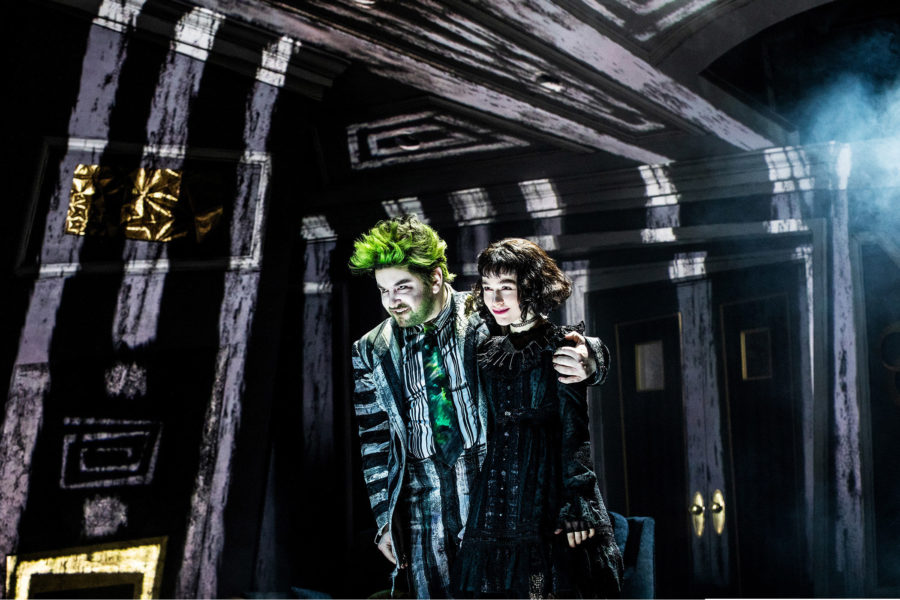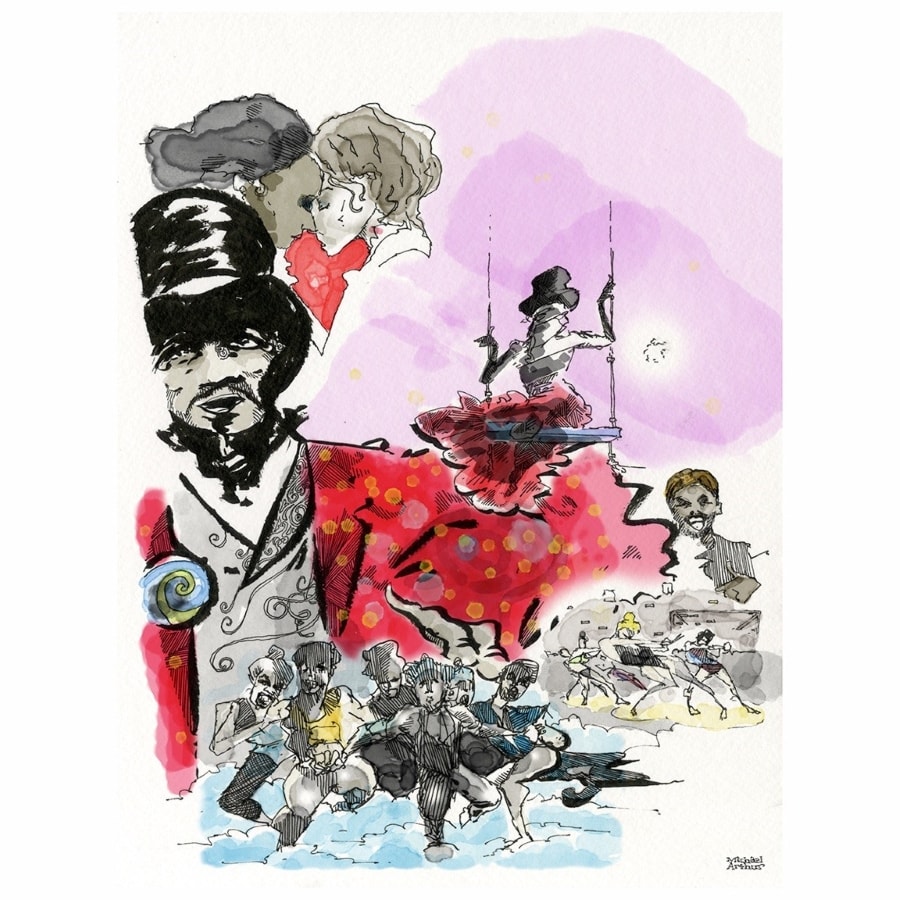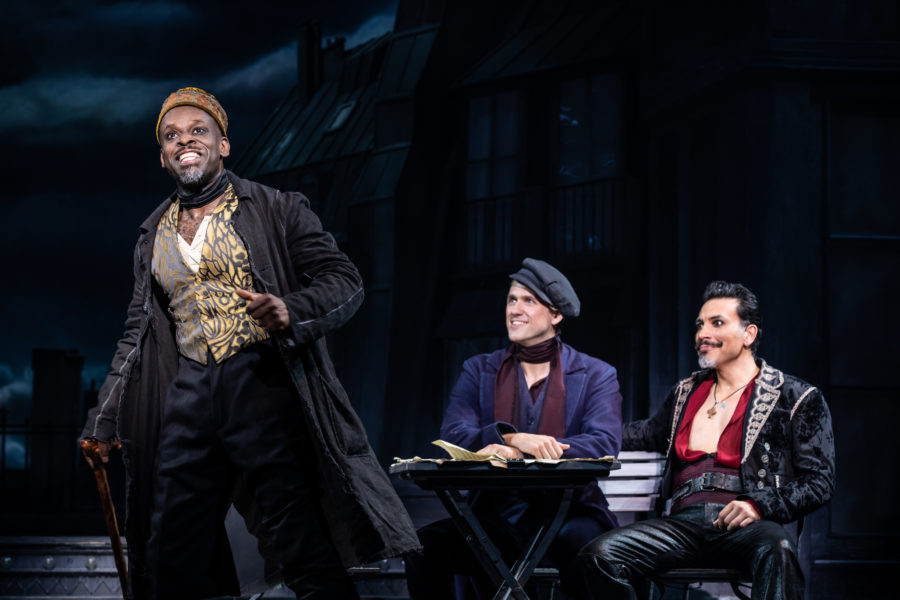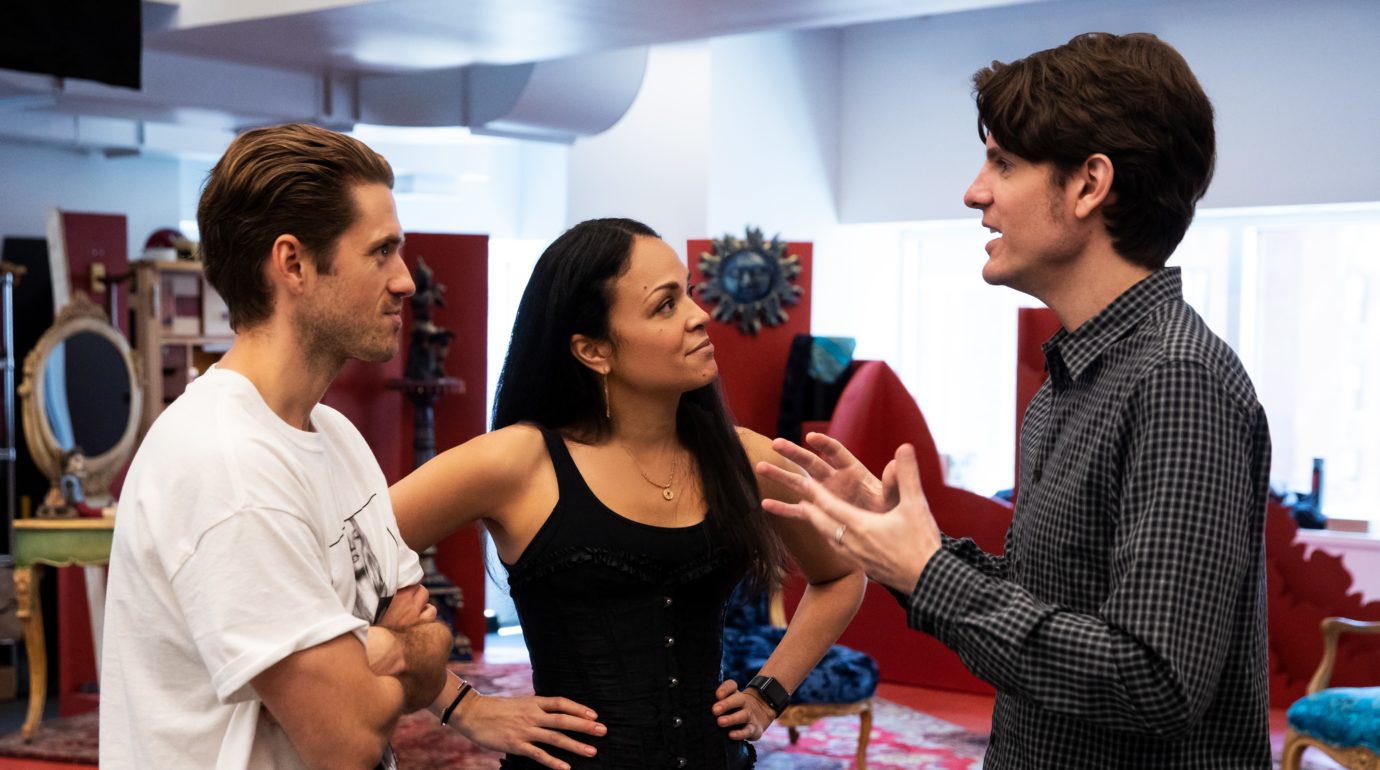When it comes to favorite movies, Baz Luhrmann’s Moulin Rouge is in my personal Top Five. The soundtracks followed me throughout my teen years and early 20s; I still own the special two-disk DVD set. I’ve sung the “Elephant Love Medley” an embarrassing number of times at karaoke. So when Moulin Rouge! the stage musical was announced for Broadway, I had a mixture of feelings.
On the one hand, here was one movie musical that seemed tailor-made for the stage (the opening even boasts fake curtains and a tiny, hyper-energetic conductor); the jukebox score was also a natural for Broadway. On the other hand, do we really need another musical adapted from a movie?
Director Alex Timbers is well aware of the latter skepticism. After all, this year he opened not one musical based on a movie but two: His version of Beetlejuice is playing blocks away from Moulin Rouge! (he also directed Rocky on Broadway). “I think obviously as a culture we consume so many movies right now and it’s a great source of storytelling,” he says, while in the middle of overseeing the Moulin Rouge! cast album recording. “I feel like there’s something very organic to the history of theatre—Shakespeare was adapting preexisting stories.” Timbers, a two-time Tony nominee, also hopes that his versions of these beloved films are distinct from their cinematic versions, from both storytelling and stylistic standpoints.
That was, after all, why he was picked to direct Moulin Rouge, according to Baz Luhrmann: “Early on, when I saw Alex’s work—Bloody Bloody Andrew Jackson and Here Lies Love—I immediately felt that although I had not met him, that his way of telling a story and his aesthetic were almost like a cousin of mine: rhythmic and dynamic in the telling, a deep humanity set inside an ironic glove, a love of the romantics in theatre and film.”
Below I talk to Timbers in detail about adapting musicals into movies and why he cut several songs from Moulin Rouge the movie (as well as adding dozens more). Freedom, beauty, truth, love, and spoilers abound.
DIEP TRAN: Beetlejuice was directed by Tim Burton and Moulin Rouge was directed by Baz Luhrmann. How did you put your own stamp on two properties whose directors gave them such specific looks?
ALEX TIMBERS: That’s a great question. Two things happened with both right at the start. With Beetlejuice I was approached by the producer Kevin McCormick about working on it. There are a lot of movies being made into musicals, and I think as a theatremaker you have to feel really passionate about how and why something needs to be told on a stage. And creating a replica of a movie onstage is not that path to making something that feels essential and necessary.
With Beetlejuice, I came back to the producer and I said to him, “Look, I’m really excited about this, but I think these three things need to be true in order for an adaptation to make sense.” One of these things was to put Lydia at the center of the whole story, and the Lydia-Beetlejuice relationship at the center. And can Beetlejuice break the fourth wall and be an Emcee-like figure? Can we set the whole thing basically in a single location that transforms, like a magic box? Kevin was incredibly supportive, and he wasn’t beholden to recreating the movie onstage and really embraced the idea of adaptation.
With Baz, he was a theatremaker for many years before he became a filmmaker. He gets the process and the requirements for the stage. His feeling was, these things need to be different and needs to be its own thing. So that was, in both instances, really liberating.

I read that you and Moulin Rouge! music supervisor Justin Levine locked yourself in a hotel room and went through the script and noted which moment could be dramatized with a pop song. Did the show expand your knowledge of pop music?
With Moulin Rouge, Baz has this amazing concept. So Justin, John Logan, the book writer, and I were able to do this amazing thing, which was to plot out an original musical and say, “What is this song beat?” And then being able to blue-sky the entire pop catalog from the last century.
One of the things that’s so true about pop music is you have a verse, you have a chorus, and you have another verse, another chorus, and you have a bridge and then another chorus. In a pop song, the chorus generally doesn’t evolve, from a storytelling and character perspective. But of course in a theatre there would be a sameness and monotony to it. Often in a musical theatre song, the bridge is where the emotional pivot of the character is within the song. So the mashup has been a real great tool to be able to ask, how do you keep leveling up, how do you keep sculpting the journey?
And the mashups also kept the audience surprised, I’m assuming, so it’s not just straight covers of songs.
Just like the stage show isn’t a recreation of the movie, here we’re not trying to recreate a song. With something like “Chandelier,” it’s, how do you look at that from a new perspective? When you get to the pre-chorus of, “one-two-three, one-two-three, drink,” it’s not at all what Sia was intending when she wrote it, but here we have Toulouse-Lautrec and Santiago [the Narcoleptic Argentinean in the film–Ed.] singing. And it doesn’t feel like a betrayal of the intent of the song; it just makes you hear the lyrics in a different way.
Were there any songs you wanted that you couldn’t get the rights to?
There were one or two things we wanted, like Nirvana’s “Smells Like Teen Spirit.” Generally we had great luck with the songs we wanted.
“One Day I’ll Fly Away” is one of my favorite moments in the movie. Why did you cut it and use Katy Perry’s “Firework” as Satine’s “I want” song instead?
In the film, there’s a little more of a sense of Satine as a princess locked in a tower. A musical theatre protagonist needs as much agency as possible. The message of “One Day I’ll Fly Away” didn’t quite make sense for the stage adaptation version of Satine.

For the show-within-a-show, tell me about the decision to scrap the Bollywood number, “Hindi Sad Diamonds,” in favor of a realistic play.
As we were exploring the tone and the necessity of making a stage adaptation, it led us to push even further into psychological realism and add a little more grit and backstory. There was a question about whether or not the Bollywood spectacular would be quite the version of Moulin Rouge we were doing. And then there was another question of: If this was Lautrec’s vision, what was Lautrec’s art doing? And what the theatrical vocabulary for that was.
One of the things that was happening at the time was there was psychological realism popping up in the theatre and in Lautrec’s paintings: He was depicting the life of the demimonde. So what was Lautrec doing that was so revolutionary and what was the theatrical analogue of it? That’s what led us in the direction of where we ended up, going to the show-within-a-show.
It does make him seem less cartoonish than in the film.
Yeah, one of the things that’s so brilliant about the film is its big tonal shifts. It has a kind of knockabout vaudevillian quality to it, and then it has this hyperkinetic, epic, swirling, music-video quality, and then it’s got this intimate, earnest poetry to it. I think that in a stage show, we don’t have all the techniques to bash from one style to the next in the same way that Baz did.
From the first conversation with John Logan, we were talking about the tone of the bohemians. I think John really saw himself in the character of Lautrec a lot; it was one of his favorite characters to write, and he really dug into what it meant to be an artist in Paris at that time. I think that unlocked it, and that went to a slightly different tonal place than how those characters are portrayed in the film.

I’m not trying to be a jerk with this question, but do you think we’re at a saturation point with movie-musical adaptations on Broadway?
I don’t know if I’m qualified to answer that. I think if you look at the history of Broadway and the history of theatre, so many shows—Fiddler on the Roof, My Fair Lady, Oklahoma!—are based on pre-existing source material. I think obviously as a culture we consume so many movies right now and it’s a great source of storytelling. There’s something that feels organic to that process and not craven.
But it seems that there’s more commercial support around movie musicals; they tend to have an easier time going to Broadway than original projects.
I guess. But I worked on Beetlejuice for 10 years, and Bloody Bloody Andrew Jackson took 6 years to make it to Broadway. I don’t think it’s quite so linear. If you look at the last season on Broadway, it’s one of the most exciting and experimental and rangy season I feel like in my adult lifetime. There’s a place for so many shows.
When I look at Beetlejuice, it’s not a straight-up adaptation of the movie; it’s almost like a fan-fiction version: Different characters are important, the plot is widely different. Everything feels inspired by the film but none of it is actually like the film. There are people who love and grew up with Beetlejuice and then these producers basically said, “Make your own Beetlejuice.” And I feel like there’s something wildly creative and fun in that.
Speaking of original musicals, if you were to write Bloody Bloody Andrew Jackson today, would you do it differently because of today’s conversations around race?The musical did generate controversy around its representation of Native American genocide.
My hope is that we’ll get to do Bloody Bloody Andrew Jackson again, perhaps in London or something like that. And I would love to look at it anew and revisit all elements. Over the years since its premiere, I’ve been able to be a part of a number of great conversations about the show and it’s made me eager to dig back in. My collaboration with composer-lyricist Michael Friedman was probably the defining collaboration for me as a young artist, and I loved working with him on the show and having the experience of creating something with a writer that unbelievably talented.


